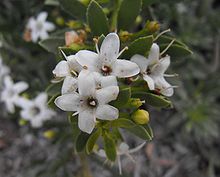- Myoporum parvifolium
-
Creeping Boobialla Scientific classification Kingdom: Plantae (unranked): Angiosperms (unranked): Eudicots (unranked): Asterids Order: Lamiales Family: Scrophulariaceae Genus: Myoporum Species: M. parvifolium Binomial name Myoporum parvifolium
R.Br.[1]Synonyms - Myoporum humile R.Br.
Myoporum parvifolium (Creeping Boobialla, Creeping Myoporum or Dwarf Native Myrtle) is a prostrate shrub which is endemic to Australia. The plant forms a mat to around 3 metres in diameter and has glabrous leaves which are 1 to 6 cm long and 1.5 to 8 mm in width. White flowers with purple spots appear in the leaf axils singly or in clusters of 2 or 3 and are 7 to 9 mm in diameter. [2]. Peak flowering times are winter to summer in New South Wales and October to March in South Australia.[3][2] The succulent, rounded fruits are yellowish-white and up to 8.5 mm in diameter.[2][3]
The species was first formally described by botanist Robert Brown in Prodromus Florae Novae Hollandiae in 1810.[1]
Distribution
Myoporum parvifolium occurs in New South Wales,[2] Victoria[2], and South Australia[3] In New South Wales it occurs in the south-west near the border with Victoria.[2] It is also used as a ground cover for xeriscaped grounds in the southwestern continental United States and considered invasive to the same region.[4]
References
- ^ a b "Myoporum parvifolium". Australian Plant Name Index (APNI), IBIS database. Centre for Plant Biodiversity Research, Australian Government, Canberra. http://www.anbg.gov.au/cgi-bin/apni?TAXON_NAME=MYOPORUM+PARVIFOLIUM. Retrieved 2008-06-13.
- ^ a b c d e f New South Wales Flora Online: Myoporum parvifolium by R.J. Chinnock, Royal Botanic Gardens & Domain Trust, Sydney, Australia
- ^ a b c "Myoporum parvifolium". Electronic Flora of South Australia Fact Sheet. State Herbarium of South Australia. http://www.flora.sa.gov.au/cgi-bin/texhtml.cgi?form=speciesfacts&family=Myoporaceae&genus=Myoporum&species=parvifolium. Retrieved 2008-06-13.
- ^ "Invasive Plants". http://www.co.san-diego.ca.us/dplu/docs/InvasivePlants.pdf. Retrieved 2008-09-19.
Categories:- Myoporum
- Flora of South Australia
- Flora of Victoria (Australia)
- Lamiales of Australia
- Plants described in 1810
- Scrophulariaceae stubs
- Australian asterid stubs
Wikimedia Foundation. 2010.

